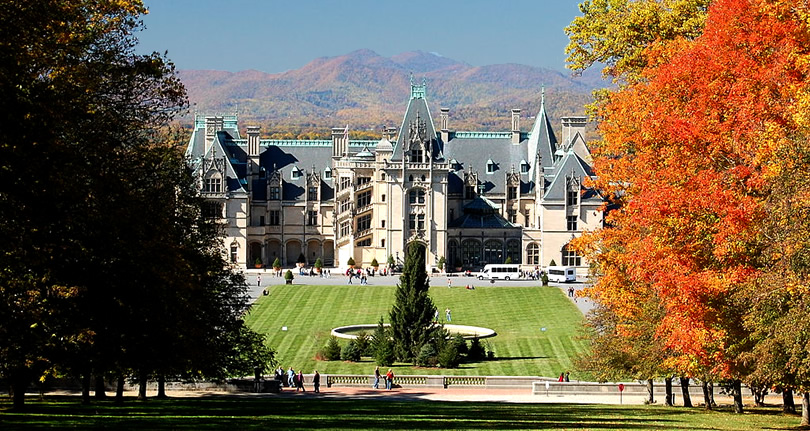
Meadowbrook Log Cabin is 30 minutes from the Biltmore Estate.
Have you ever visited the Biltmore House, Gardens and Grounds?
The Biltmore House is the largest privately owned house in the United States with four acres of floor space and 252 rooms. Wander the 2.5 acres of manicured gardens. Or hike the nearly 22 miles of well-maintained trails on the 8,000-acre Biltmore Estate Grounds.
The Biltmore House
Explore this beautiful home. The tour is self-guided, so you can wander at your own pace and imagine yourself living amidst the luxury of the Gilded Age. This is the largest privately owned house in the United States and all three floors and the basement are open and furnished as if the occupants have just walked out of the rooms.
You will marvel at the sumptuous Banquet Hall with a 70-foot ceiling hung with 16th century tapestries and original art by Pierre-Auguste Renoir and John Singer Sargent. George and Edith Vanderbilt’s original art is throughout the house. The Library has their 10,000 volumes.
Biltmore has four acres of floor space with 252 rooms; thirty three are bedrooms, forty three bathrooms, sixty five fireplaces and three kitchens, an indoor pool, and a bowling alley.
Your admission includes a self-guided visit to Biltmore House on a marked route, assisted by knowledgeable guides along the way. Touring the home takes 1.5 to 2 hours, depending on your pace.
Biltmore Gardens & Grounds

George Vanderbilt hired Frederick Law Olmsted to design the grounds for his home. He is best known for his design of Central Park, Prospect Park and other public parks. Look for his portrait by John Singer as you tour the estate. Olmsted recommended planting much of the grounds in timber.
Olmsted and Druid Hills, Hendersonville
Druid Hills, one of Atlanta’s most affluent neighborhoods was designed in 1893 by Frederick Law Olmsted. Druid Hills in Hendersonville, where Meadowbrook Log Cabin is, was designed in 1923 along Olmstedian principles by Earle Sumner Draper. Draper worked with Olmstead’s sons.
Vanderbilt hired Gifford Pinchot to manage the forests. When he was named Chief of the United States Forest Service, Carl A. Schenck was engaged. Schenck establishing the first forestry education program in the U.S., the Biltmore Forest School, now called the Cradle of Forestry in America, on the estate grounds in 1898.

Photo by Doug Coldwell
Take a look at the Lodge Gate as you enter the Estate grounds. It is brick quoined with pebbledash stucco. The bricks and roof tiles were made on the Estate. Then drive up the rustic three-mile Approach Road through deep natural forest with pools, springs and streams. It still reflects Olmstead’s design, natural and uncultivated looking.

The Walled Garden with tulip beds and main Conservatory
Photo by Doug Coldwell
Olmstead designed 75 acres of formal gardens surrounding the house, with an Italian formal garden, walled garden, shrub and rose garden, fountains and a conservatory with rooms for palms and orchids.
The yard also has a bowling green, outdoor tea room, pools and a tree-lined esplanade with European statuary. Look for the marble statue of Diana inside a small temple at the top of the hill. Behind it is a brick-lined reservoir to help provide water for the estate.

Photo by Upstate Herd
Olmstead incorporated two water features in his landscaping, look for the Bass Pond and the Lagoon.

Photo by Kristie Bracag
Horticultural experts continue to preserve Olmstead’s vision for the formal and informal gardens and the estate grounds. Look for the Italian Garden and the Rose Garden that features more than 250 varieties. The managed forests are just beautiful, with trails to hike ranging from very easy walks to more strenuous hikes. Your admission allows you to spend the day exploring. Wander the 2.5 miles of paths in the manicured gardens.
Featured Image Autumn at the Biltmore Estate, North Carolina
Photo by R. L. Terry



You must be logged in to post a comment.